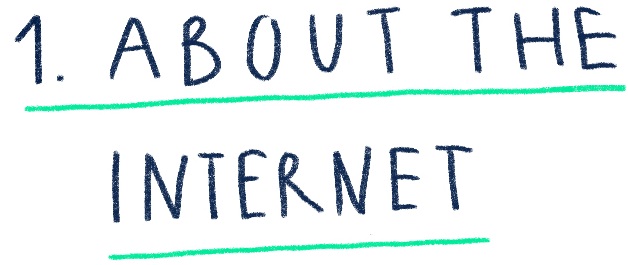GUIDING QUESTIONS
How can we connect to the internet?
What is the role of internet service providers?
LEARNING OBJECTIVES
This story
demonstrates that those parts of internet infrastructure run by internet
service providers (ISPs) are crucial to providing internet connectivity to
the larger population.
The internet is made of multiple layers, each of
which serves specific functions.
The content
layer depicts what users share online, that is videos, blogposts, pictures,
etc.
The application
layer helps users send and receive information via readable interfaces,
including web-based platforms, email, and instant messaging. Internet service
applications, like Google or Facebook, help you use and navigate the internet;
otherwise, everything would be in coding language!
The logical
layer includes all standard protocols supporting the connections between
devices and the applications running on them. Most institutions that host the
technical and logical standards by which the internet works are based in the
USA.
Most importantly,
the infrastructural layer is about the physical infrastructure—that is
the cables, wires, phones, computers, and routers—needed to establish and
maintain connection.
Interconnected
across the globe via copper cables, fiber optic cables, or radio waves, the
small local networks of computers on which the internet relies belong to
various ISPs that enable ‘last-mile’-connections to end-users. With ISPs there
exists an industry-wide capacity to grant and restrict access to manifold
internet-based services on which an increasingly digitalized economy and
society relies.
REFERENCES
ARTICLE 19 & Catnip. 2021. How the
Internet Really Works: An Illustrated Guide to Protocols, Privacy, Censorship,
and Governance. No Starch Press.
A playful introduction to the internet’s
physical infrastructure. Using humorous illustrations, it explains how the
internet is networked and what the internet’s infrastructure looks lik.
DENARDIS, L. 2014. The Global War for Internet
Governance. Yale University Press.
An introduction to the power structures inherent in the architecture of
internet governance. It reveals how the control over local internet
infrastructure puts ISPs in a powerful decision to provide, manipulate, or cut
internet access.
FLYVERBOM, M., DEIBERT, R. & MATTEN,
D. 2019. The Governance of Digital Technology,
Big Data, and the Internet: New Roles and Responsibilities for Business. Business
& Society 58(1): 3-19.
This special issue explores the so-called “Internet-industrial
complex”—the intersections between business, states, and other actors in the
shaping, development, and governance of the internet.
FREYBURG, T., GARBE, L. & WAVRE, V.
2021. The Political
Power of Internet Business: A Comprehensive Dataset of Telecommunications
Ownership and Control (TOSCO). Manuscript. University of St.Gallen.
An original discussion of the role of ISP ownership for the political
and economic effects of internet penetration. Mapping the dynamic
telecommunications landscape in Africa since 2000, it analyses different
ownership types, notably the state, private investors, and family/individuals,
and their role in corporate decisions on government-requested shutdowns, among
others.
GOLDSMITH, J. & WU, T. 2006. Who
Controls the Internet? Illusions of a Borderless World. Oxford University
Press.
A provocative discussion of the challenges to
the internet as a liberation technology. Building on a series of practical
examples, it shows how governments seek to assert their power to direct and
control the use and expansion of the internet.

Authors
Véronique Wavre
Lisa Garbe @LaserGabi
Tina Freyburg @TFreyburg
www.ipw.unisg.ch
University of St.Gallen IPW-SEPS
Müller-Friedbergstrasse 8
CH - 9000 St.Gallen
Illustration
Pia Valaer
pia@valaer.ch
www.piavalaer.ch
Flüelastrasse 16
CH - 8048 Zürich
To request additional educational material (e.g. posters, postcards, printed version), please contact Tina Freyburg: tina.freyburg@unisg.ch

.













